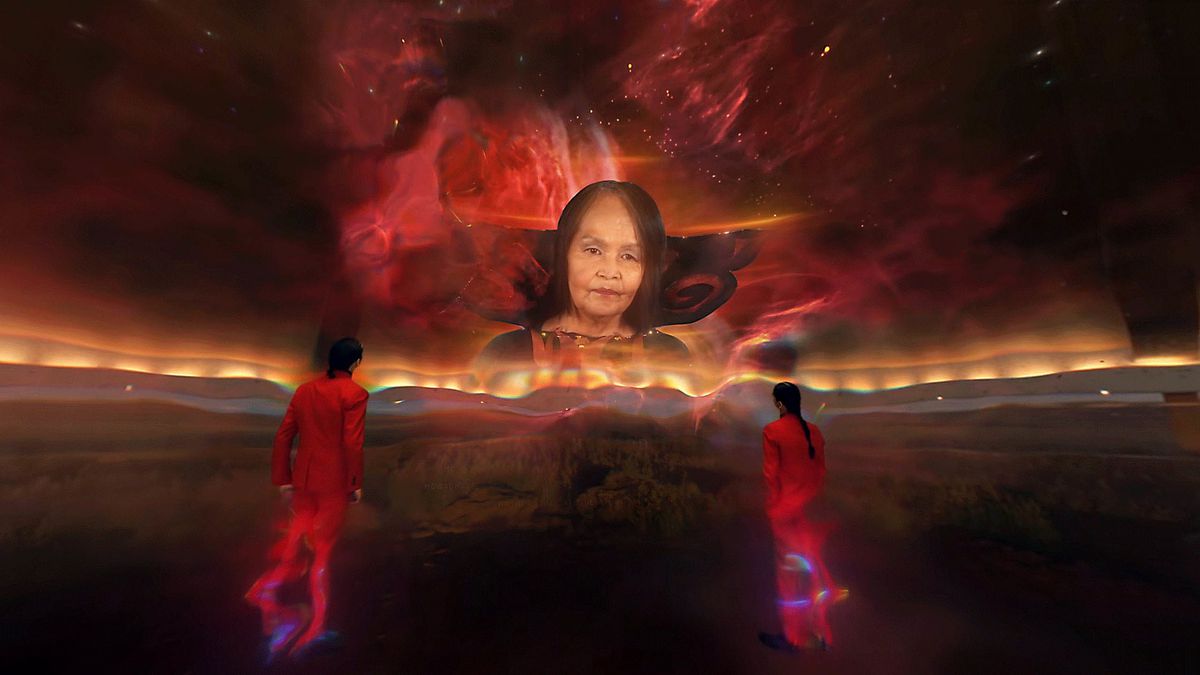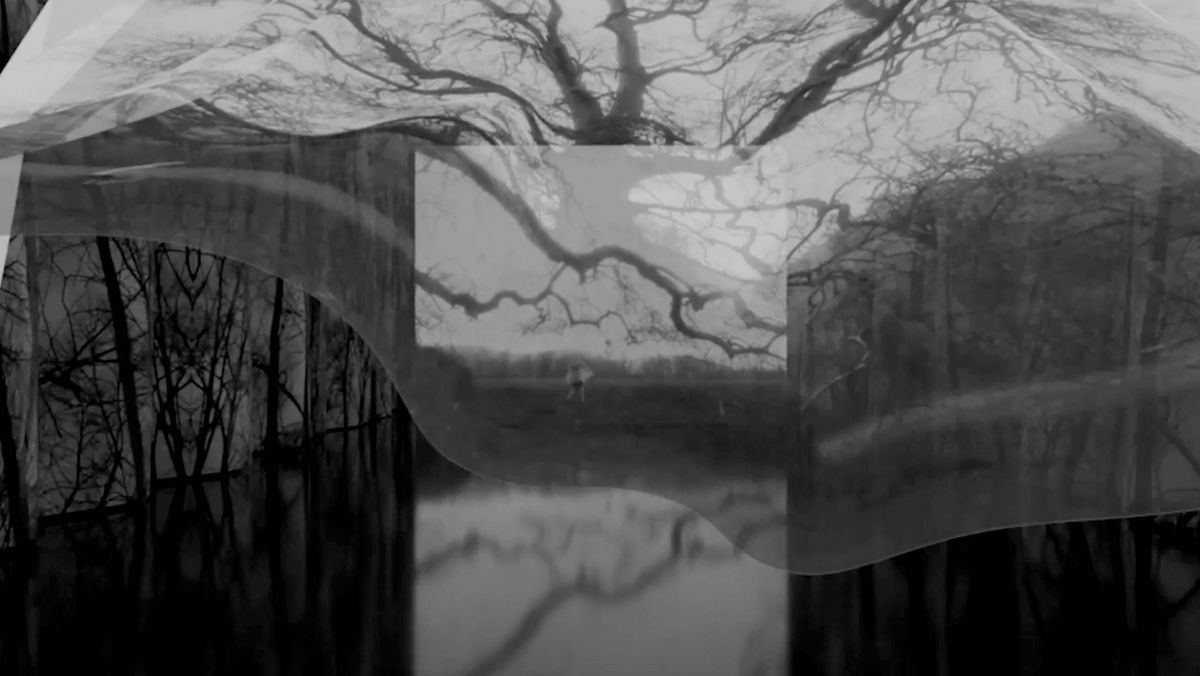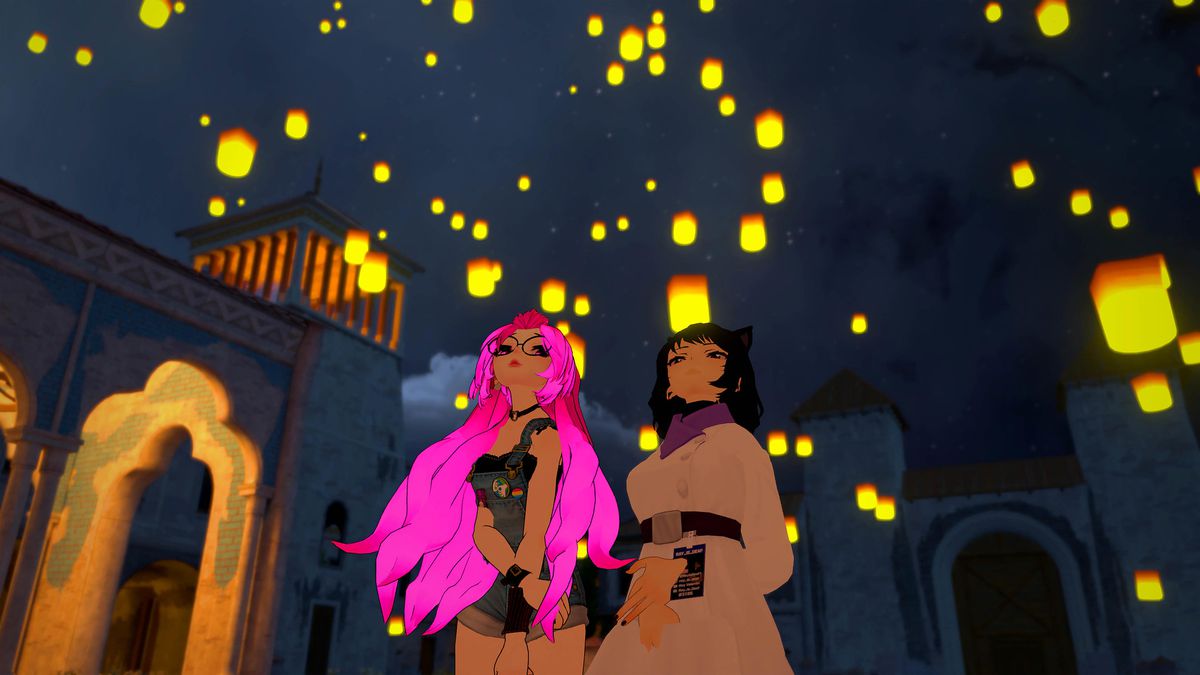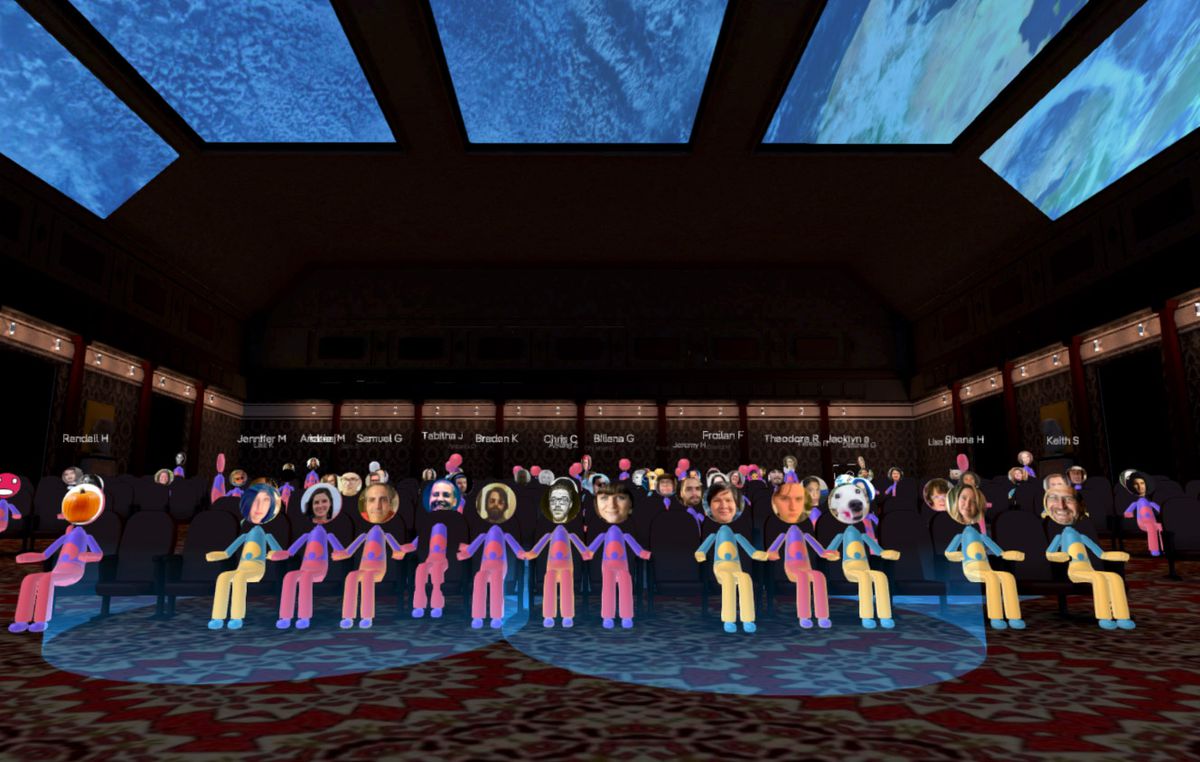I sat on my couch, a virtual reality (VR) headset strapped to my face, my feet hovering over a campfire. If I craned my neck up, I could see the stars. Two trickster poets, young Indigenous men, approached me and looked me straight in the eye. They’d just guided me through true, heart-wrenching stories about other Indigenous men: one who was abused in foster care as a child, and one who died waiting for care in a hospital emergency room for 34 hours. Now, the poets told me, it was time for me to bear witness and consider what my role in the story might be.
The intimacy of their gaze was a little uncomfortable. It was nothing like watching a movie in which someone looks straight into the camera. I was aware of my eyes, my face, my expression, my impulse to look away, even though I knew they couldn’t see me.
“I wanted people to look them in their eyes, and be able to see their faces closely, clearly in a different way than you would see in 2D media,” the director of This Is Not a Ceremony told me when I called him afterward. Colin Van Loon is a native artist from Alberta’s Piikani Nation; he works under his traditional name of Ahnahktsipiitaa. He hoped that experience might foster a deeper understanding of the stories themselves.

A still from This Is Not a Ceremony by Ahnahktsipiitaa, with two trickster poets in the foreground.
Sundance Institute
He was right. But it sure wasn’t what I had expected.
I’ve been accustomed to thinking of VR as a platform for escape — leaving this world and entering a “fake” one. It’s often depicted that way in dystopian fiction, or in movies like Ready Player One.
My experiences with VR have been decidedly mixed, whether at festivals or in museum exhibitions; that feeling of dissociation was often reinforced. That rubs me the wrong way because I strongly believe if we choose to habitually disconnect from our physical reality then we risk losing what makes us human. And even when artists have the best intentions, sometimes the art just doesn’t work for me.
Every year at Sundance, I’ve wandered through the Festival’s New Frontier section — usually hosted in a big building in downtown Park City, Utah — looking at pieces about identity and imagination and, one year, the ways that scientists are using VR to retrain the brains of paraplegics.
Sometimes it is startling and thought-provoking. I’ve thought about the medical use of VR many times in the years since. But other times it has felt like sitting through a 10-minute 3D sermon, or an Epcot exhibit, or a very janky version of The Sims.
Van Loon’s piece stuck with me not just because of the subject matter, but because it made me aware of my own body in a startling way. I hadn’t felt like a floating avatar or a ghost, as sometimes happens in VR; I was very aware of my own physicality. The experience rested in the back of my mind, like a lingering dream.
This Is Not a Ceremony was among the most affecting pieces I’d seen in 2022’s New Frontier section. This year, about three weeks before the festival was slated to begin, Sundance pivoted from an in-person event with robust virtual offerings to a fully virtual event. But New Frontier was the least affected section; the Festival had already announced that the section would be entirely hosted in the Spaceship, their VR platform. (The “spaceship” metaphor furnished some fun visual touches; in some places, you could look out the windows and see the earth passing below.) A plethora of interesting projects was accessible via computer, VR headset, or mobile device.

A still from They Dream in My Bones – Insemnopedy II, part of Sundance’s New Frontier section in 2022.
Sundance Institute
Roaming the Spaceship’s gallery during Sundance revealed that artists are thinking about VR in many different ways. For instance, Seven Grams, directed by war correspondent Karim Ben Khelifa, turns audiences’ phones into portals to see the human cost of creating those very devices. On the Morning You Wake (To the End of the World), which I watched through a headset, is a virtual reality documentary that immerses the audience in the experience of waking up to the 2018 ballistic missile alert in Hawaii. I watched — or, really, listened to — 32 Sounds, a documentary that felt like bathing in aural sensation. They Dream in my Bones – Insemnopedy II, by the artist Faye Formisano, takes the viewer on a journey through a fluttering dream reality lodged in the bones of a skeleton. (It’s trippy.)
Yet Van Loon’s perspective startled me. “I’m very excited by this idea that [VR] connects the mind and the body,” he says. Wait, what? I thought. Then, as he went on to remind me that VR more or less short-circuits the ways the brain deals with images, I realized he was correct. You might jump the first time a monster appears in a horror movie, he says, but probably not the second or third time you watch the movie. But in a VR experience — he cites one in which you’re standing on top of a tall building, feeling vertigo — your brain can’t quite handle it, and your body reacts: “There’s nothing I can tell myself that will take away from this reaction, and I think that’s such a powerful tool for storytelling, whether it’s fiction or nonfiction.”
In other words, the distance I can place between myself and the image onscreen in a movie evaporates in VR. Whether that might evaporate in the future for people who spend hours and hours in VR remains to be seen, but the immersive, disorienting experience that many hardcore gamers still experience during gameplay suggests it may not.
That also makes VR a unique space in which to create art. One of the best films in the festival was an extraordinary documentary entitled We Met in Virtual Reality, directed by Joe Hunting and entirely filmed on the social VR platform VRChat. I confess that I expected the film to be gimmicky. I was totally wrong. Instead, it’s a beautifully shot meditation on connection and finding a community where you belong, featuring subjects who’d found genuine friendships and relationships in VRChat that extended into the physical world.

A scene from We Met in Virtual Reality, a stunning documentary shot entirely on the VRChat platform.
Sundance Institute
Hunting and I talked via Zoom, and he told me that he actually shot his movie as an avatar, holding a virtual camera, replicating the experience of real-life production: adjusting aperture, shooting handheld, and zooming in and racking focus, just as he would in a physical production. Hunting also described an “intimate tension” that exists between filmmaker and subject in that space, between himself and the people he interviewed in the film, which combines conversations with observational techniques. It’s something he hoped to replicate for the audience, who might forget they were watching VR and not “reality.”
And he’s hopeful that the virtual platform will make space for other great art to be created across time and space, in a way that simply isn’t possible in the physical world. Hunting wonders if, in the future, VR will be “just another space that we’ll easily transition into whenever we want to go and see something that we can’t quite reach in the real world.” That, to me, seems quite feasible — that I might want to watch a theater piece or participate in a conversation or take a class (subjects in his film teach sign language and belly dancing) in a more immersive way than logging into Zoom or watching a livestream. In VR, I don’t have to just watch; I can participate.
Participatory VR was a big theme in this year’s Sundance Spaceship, which admittedly was a little intimidating for me. But wearing a VR headset, I went as an avatar to one of the Spaceship’s virtual venues, the Cinema House, to watch a talk between artist and technologist Amelia Winger-Bearskin and writer and curator Jesse Damiani.
Two days later, I met Winger-Bearskin, this time with my real face on, in the virtual reality facilitated by a more familiar technology: Zoom. I wanted to ask her about her experience with and hopes for art in VR.
“I like to think of VR as a dream technology,” she says, putting words to what had lingered in my subconscious after This Is Not a Ceremony. Winger-Bearskin, who holds an endowed chair at the University of Florida’s Digital Worlds Institute, where she is an associate professor of artificial intelligence and the arts, is also Haudenosaunee (Iroquois) of the Seneca-Cayuga Nation of Oklahoma, Deer Clan, and draws on her own tradition when thinking about virtual reality.
“In my culture, dreams and dream medicine is a really powerful and traditional thing through which we connect with our higher selves and our ancestors,” she went on to explain. And by thinking about VR through the metaphor as a dream — an idea that was reinforced when a friend recounted a dream to Winger-Bearskin, only to realize it was actually a VR art project of hers they’d mentally processed as a dream — then perhaps there are possibilities there, too.
That all sounds too optimistic, but the more I considered what Winger-Bearskin was saying, the more I realized this is what art is always trying to do. The goal of great art is never just to provide an escape from this world. It’s to dislocate the audience — the reader, the watcher, the listener, the viewer — from their present context so that when they return to it, they see it differently. Escape has its place, but great art eventually directs us back to the world around us, helping us see it in a new way, and more importantly, see what it could be.
Yes, VR can be merely escapist. But every artist I spoke to raised the same potentially counterintuitive point as Van Loon: that VR art can connect us to our bodies and the physical world when it helps us “re-see” our reality.
That can present challenges for artists, depending on what they’re aiming to do. “I think it’s very hard to do something preachy to someone in that space,” Winger-Bearskin says, “because you’re like, ‘Well, look, I’m putting this on my face. This is now in my body. You’re close to me, and I don’t really know if I want you to talk to me.’”
Similarly, Van Loon notes, there’s a danger in depending on VR too much to create “empathy.” “It’s something we have to be very careful with,” he says. “It’s terrible that somebody can watch somebody’s life, take off the headset, and forget about the act of witnessing.” In creating a piece that he hoped would have an effect on the viewer, “I wanted to give audience members a real task or responsibility, a duty, something they can carry forward after the film is finished,” he says.
And the VR artist is facing a world rife with challenges. The technology is still expensive and not always easy for your average person to use, if they even want to. There’s also the mounting danger of “colonization” of VR spaces, as Winger-Bearskin terms it, by companies like Facebook, which recently renamed itself Meta and sells the Oculus Quest headset that I was using to access the Spaceship. (I was nonplussed by the discovery that I had to revive my long-deactivated Facebook account in order to log into the headset.) And finding new distribution models for art in VR is going to be tricky, as several artists noted.

Avatars gathered in the Cinema House for the Sundance premiere of 32 Sounds.
Sundance Institute
If we’ve learned anything from the last few decades of the Internet, those aren’t small hurdles. But the work itself still brings a lot of joy. Documentary filmmaker Sam Green had come up with a delightful plan to debut his 32 Sounds on Sundance’s opening night, with a flesh-and-blood crowd and a virtual crowd being able to see each other filing into their respective theaters before the film began. “So the virtual world and the real world would combine, and everybody would look at each other,” he says to me via Zoom, laughing.
In the end, 32 Sounds only premiered in virtual reality. It’s a documentary about sound, designed to be watched as a film while wearing headphones, or live via a full VR headset. The sound is carefully designed so that you feel like you’re in the film, rather than just an observer, in a way that’s even more immersive than a state-of-the-art movie theater. (Also, at one point, there’s a five-minute dance break.)
Green’s goal was that audiences would find themselves listening to ordinary sounds — a bird, a barking dog, a faucet in the next room — with a totally different set of ears after experiencing 32 Sounds. “There’s a way in which engaging your ears and being open to the sounds around you is very pleasurable, and deep, and a transformative experience,” Green says. “I liked that idea of a movie with a very simple ambition to not change the world, or to get somebody off death row, but just change the way people engage with the world in a small way, in a measurable way.”
For Van Loon, inspiration for reimagining the world through his art lies in his own nation’s tradition — specifically around time. “We don’t have many words for the future or the past,” he tells me. “We have a word for yesterday, and we have a word for the day before yesterday. We have a word for tomorrow, and we have a word for the day after tomorrow.”
That mental model informs his work. If VR art can compress space and create intimacy, then it can recreate that feeling of being close to your own ancestors and descendants across time, as This Is Not a Ceremony does. Thinking about his great-great-great-grandfather or his future grandkids as only two days away, “changes the way you look at things, the way you do things,” he says.
Using VR to help audiences re-situate themselves in space and time might be able to change the way they see the world. And in the end, that’s what the art that lingers in our subconscious — like a dream with some insight for us to attend to — can do best.